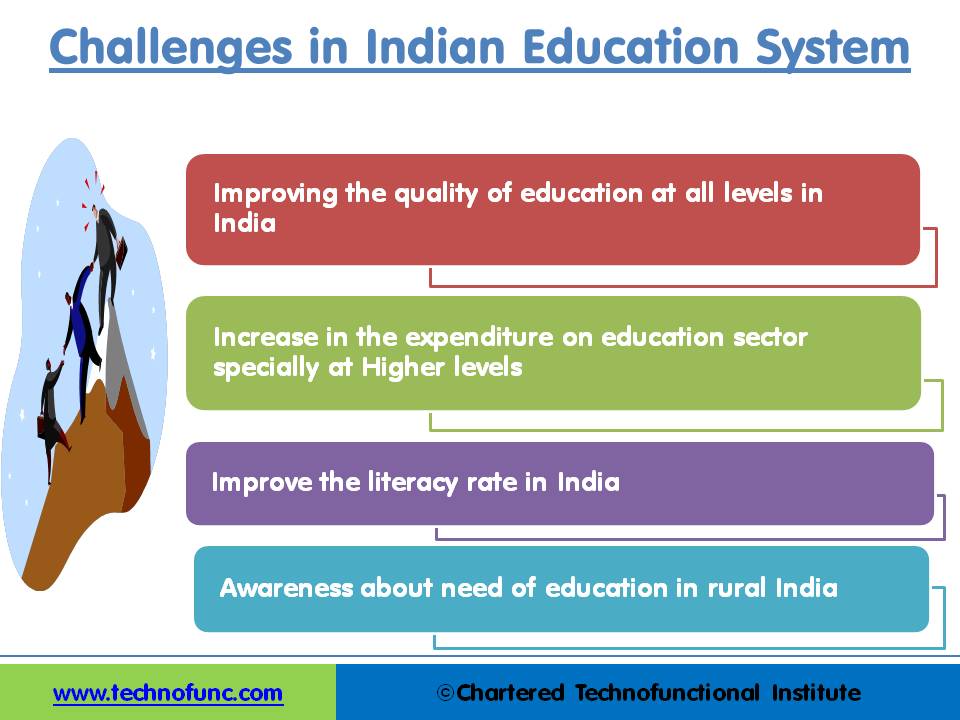- Home
- Business Processes
- Industry Knowledge
- Aerospace Industry
- Automotive Industry
- Banking Domain
- BFSI Industry
- Consumer/ FMCG Industry
- Chemicals Industry
- Engineering & Construction
- Energy Industry
- Education Domain
- Finance Domain
- Hospitality Domain
- Healthcare Industry
- Insurance Domain
- Retail Industry
- Travel and Tourism Domain
- Telecom Industry
- Leadership Skills
- eLearning
- Home
- Industry Knowledge
- Education Domain
- Challenges in Education System
Challenges in Education System
The Education sector underwent some major changes over the past five years. Enrolment in private schools outpaced government school enrolment for much of the period. Tutoring businesses and universities have offered new services to expand their market base. Online education is a major development for the Education Division, and technology is permeating all areas of education. Understand some of the major challenges that are faced by the education sector today.
Education Industry Challenges:
Despite the intense progress in education achieved during the last decade, both at the national and global levels much remains to be done. The challenges that education industry players and companies face in the marketplace are explained below in this article:
Controlling Costs:
The very best schools have the best resources available to them and to their students. However, all these resources cost money, and this can be challenging for most schools, especially those that are either publically funded or operate for no-profit. Even some of the top schools which charge relatively high tuition, must pay salaries, maintain their grounds, and fund research and employ the best-skilled workforce to maintain their credibility and reputation. This means allocating resources to pay for the teaching and research activities, as well as salaries for professors and other staff. These financial considerations can constrain an educational institution, and keeping all these costs under control is one of the most challenging activities for most schools.
Cost & Performance Ratio:
Another issue facing the education sector is that in spite of rising education costs the student's test scores are not showing improvements to a comparable scale, they remain the same or improve very little. The industry needs to innovate and find a variety to serve a wide range of student interests, aptitudes, and learning styles. Different schools incorporate different teaching methods and children have different learning styles.
Standardized Learning:
A major challenge is to improve the quality of education at all levels and make it par with the international standards. Historically, education has been focused on standardization however this type of education system has proved not to work for all students. Not only does it make it difficult to discern a student's individual talents and aptitudes, but the demand for educational institutions to produce a unified product also creates student disinterest. Also, all students learn differently. Standardized learning doesn't take into account the differences in age, gender, ethnicity, or family background that can lead to students succeeding or failing in such an educational environment. Emphasis is required on mandatory rigorous quality training to the teachers before employment and improving the curriculum by employing advanced technology and smart education methods.
Demand & Supply Ratios:
In recent years, post-secondary institutions have had large applicant pools to choose from. However, the number of secondary school graduates has been declining, and schools have had to compete against each other for potential students. Foreign schools play a role in competition for students as well – as more and more schools in other countries aggressively compete for students, domestic institutions will have to work even harder to meet students' needs.
Changing Economic Needs:
The major goal of the educational system has always been to prepare students for the workplace. In the past, this meant one of two things: either a student graduated from a secondary school and went to work in a manufacturing job, or a student went on to pursue higher education. But recent developments in the global economy mean that the education industry must adapt to these changing needs as well. In the current economic scenario, manufacturing jobs are disappearing and there's a significant increase in knowledge, information technology, and service-based jobs. Growing cities are filled with jobs in the information technology industry while traditional manufacturing jobs are becoming scarce. The sector needs to adapt to changing needs where on one hand, displacement of workers who lack the necessary skills and the prerequisite general education to learn new skills rapidly, and, on the other hand, a shortage of qualified workers for the new industries and modes of production and perform service industry jobs.

Availability of Skilled Workforce:
The education industry is facing a huge shortage of educated professionals to fill jobs as growing demand for skilled workers outpaces their availability. The relative supply and demand for teachers, administrators, and other certified, and non-certificated personnel is not able to keep pace with the changing economic scenarios, there is a significant undersupply of educators and unable to consistently train sufficient numbers of personnel to close the gap. There are other reasons for this shortage of educated professionals. For one thing, demographic shifts are changing the makeup of many of the world's populations. In India, for example, half of the population is under the age of 25 and if these economies are to grow, education and skill-set development are absolutely necessary.
Infrastructure Development:
Another challenge is to increase the expenditure on the education sector especially at higher levels, professional courses, research institutes, development institutes, etc. Negotiating the need to share the burden of funding higher education between the public and private sectors have been a continual problem for all the governments. Consequently, the balance between the public and private sectors becomes almost synonymous with a balance between excellence and access.
Despite the government’s efforts, the literacy rate has been sluggishly improving in all developing nations. The absence of adequate school infrastructures like improper facilities and inefficient teaching staff is one of the main factors affecting literacy rates. Absolute poverty has also deterred the pursuit of formal education as education is not deemed of as the highest priority among the poor as compared to other basic necessities. This is another impediment to the growth of the education sector.
Rural Education:
In developing economies, the condition of rural education is still improving, the conditions of these rural schools are still very poor. There are very few schools in the rural areas and children have to travel far away distances to avail of these facilities and most schools in these locations do not provide drinking water. The quality of education is also very poor. The teachers get very less income so, most of the time the teachers are either absent or they do not teach properly. There are many initiatives taken by the government, but they are not implemented in the schools, so the present scenario remains the same. Even today, in rural India, sons are considered as the torchbearers of the family, thus educated whereas females are put to household work and are forced to help in the agricultural activities. Female education is not given due attention. Therefore the need to create awareness among people for education is strongly felt.
The marketization of Educational Services:
The relationship between the marketplace, the state, and the education sector is evolving significantly. Education is no longer a monopoly of the state or a "protected industry." Local and transnational private entities have entered this field as a result of expanding economic liberalism, increasing political pluralism, and rising demand for education. Government funding has not been able to cope with the evolving demands, and new providers have entered the market in large numbers. In fact, the growth of private tertiary education institutions in developing countries has been more rapid than it has been in industrialized countries. A large number of the new providers are private, nongovernmental institutions, many of them established in partnership with American or European institutions of higher learning, and most are profit-driven and, therefore, accessible only to those who can afford them.
Related Links
You May Also Like
-
The education industry is expanding rapidly and its many businesses are eager for new talent, including experienced professionals and enthusiastic individuals just entering the workforce. The education industry can be described as the collection of organizations and businesses that provide products and services aimed at enhancing the quality of education in society. Read more to gain a complete overview of the education industry.
-
Challenges in Education System
The Education sector underwent some major changes over the past five years. Enrolment in private schools outpaced government school enrolment for much of the period. Tutoring businesses and universities have offered new services to expand their market base. Online education is a major development for the Education Division, and technology is permeating all areas of education. Understand some of the major challenges that are faced by the education sector today.
-
How to Improve Education System
The education industry today is faced with many challenges, and in order to improve the education system and the performance and development of the education industry, the major improvement must be made in the sector. This article discusses the major components that need to be worked upon to create an effective improvement strategy.
-
Importance of Education Industry
Nelson Mandela has said, “Education is the most powerful weapon which you can use to change the world.” The following article touches on some aspects that highlight the importance of education industry for human society.
-
Different governments and different standards classify levels of education differently. There is a difference in nomenclature that is in practice today. However, for the purpose of simplicity, all classifications can be mapped to the grid provided in this article. Given below are commonly used different levels in the education process.
-
The education industry is divided up into four sectors, which all have their own roles and functions. Each of the sectors caters to a growing demand for cutting-edge education products and services. Each category has distinct market segments, all of which are defined in this article below. For learners to understand the dynamics of the education industry, having a clear picture of the industry is crucial. This understanding will help in researching education companies, determining a career path, and even exploring potential employers.
-
History of Education & Its Growth as an Industry
Education in its general sense is a form of learning in which knowledge, skills, and habits of a group of people are transferred from one generation to the next through teaching, training, research, or simply through autodidacticism. This article takes you through the history of education and its development as an industry.
-
What drives the Education Industry
In the section, we will discuss the drivers of the education industry. Business drivers are influences, both internal and external, that significantly impact the direction of an industry. This will help the learner understand the internal and external factors that have a significant influence on the education industry.
Explore Our Free Training Articles or
Sign Up to Start With Our eLearning Courses

About Us
Learning
© 2023 TechnoFunc, All Rights Reserved








